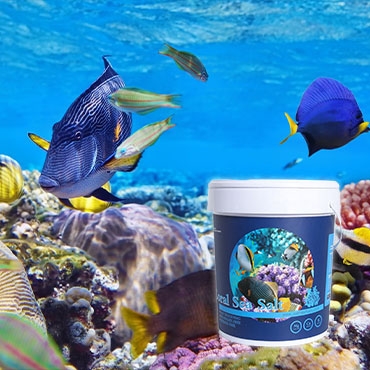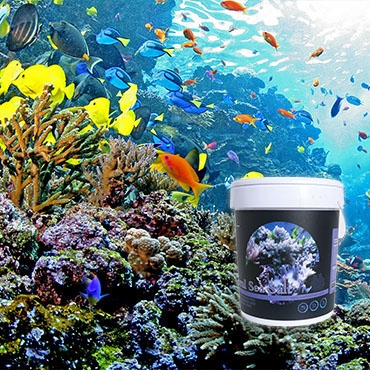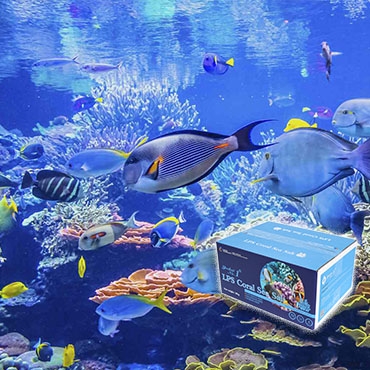278 Tianshan Second Road, Jimo District, Qingdao, Shandong
News
What is the specialized salt for mariculture
1. The role of specialized salt for mariculture
1. Salt water can be used for seed selection, and when selecting crop or tree seeds, the salt water method is usually used. The specific gravity of seeds is different from that of saline water of the same volume. Pour the seeds into a suitable concentration of saline water, and the plump, intact, and heavier seeds will sink. Due to their small specific gravity, blighted, diseased, and broken grains can float on the water surface and be easily removed.
2. Salt can be used as fertilizer. In southern China, there is a habit of using salt as fertilizer. Crops such as sugar beets and celery often increase yield when supplied with a small amount of sodium salt. When crops such as wheat, barley, cotton, and peas lack potassium, timely supply of sodium salt can also increase their yield. Adding a small amount of salt to Organic fertilizer can strengthen the activity of microorganisms, promote the release of effective nutrients and improve fertilizer efficiency.
3. The seabirds in the zoo must be fed salt. Marine animals have salt glands in their bodies, which are like desalination devices. These animals, after consuming high salt content food and seawater, excrete excess salt out of the body through the salt glands. If they leave the marine environment without receiving an appropriate amount of salt, they cannot adapt.
2. What is the function of specialized salt for mariculture
Reasons for adding salt to water
1. Adjust the Osmotic pressure of water: The purpose of adding salt is to adjust the Osmotic pressure of water, reduce the permeation of water to fish body, reduce the burden of gills and kidneys, reduce the pressure of osmotic regulation system, and improve the disease resistance of fish.
2. Blocking bacterial reproduction: adding salt can reduce the negative consequences of temperature rise. Although temperature rise can accelerate bacterial reproduction, the Osmotic pressure of water after adding salt is reduced, which can prevent bacteria from entering the body of fish to the greatest extent. Therefore, temperature rise and salt addition are complementary.
3. Inhibition of bacterial infiltration: because the Osmotic pressure inside and outside biological cells is different after adding salt, water molecules move from low salinity to high salinity, resulting in dehydration of cells to kill some organisms. The mechanism of salt sterilization still lies in the reverse osmosis effect of bacterial cell membranes by changing the specific gravity of water, thereby killing bacteria.
It is not recommended to add salt normally. Salt water is not conducive to wound healing of freshwater fish, because it will also kill newborn cells, harmful bacteria, etc. adapt to higher salinity, and then adding salt will have no effect.
2、 Precautions for adding salt to water
1. Fish disease treatment: Adding salt is the right time only when fish need treatment. Adding salt every time the water is changed will reduce the fish's osmotic regulation ability, and the effect will be poor when the fish is truly sick, which cannot be done normally.
2. Water quality issue: Improper salt addition can worsen the condition, and when the water quality issues, your fish has already suffered certain damage. If the water quality is not controlled and salt is added, the water quality will be once again damaged, causing the fish to be attacked again.
3. Do not use seasoning salt: It is best to use crude salt or aquarium specific salt when using salt, and do not use seasoning salt containing additives, such as iodized salt. Salt should be dissolved and filtered before adding. The salt concentration should be gradually increased within 1-2 days to avoid Osmotic pressure shock of fish.
4. Safe concentration of salt: the concentration of salt added must reach 0.3% -0.5% to play the role of regulating Osmotic pressure, which is very safe for most fish. Some fish, such as some soft water fish and some catfish, are very sensitive to sodium chloride and should be cautious when using salt.
5. Too light does not work: Many people dare not add more salt when treating fish diseases, but sprinkle more salt than usual. Adding too light salt concentration can only slow down bacterial growth and cannot kill it. Sprinkling a few handfuls of salt will not have any bactericidal effect at all.
6. Excessive salt is harmful: excessive salt will cause excessive Osmotic pressure, which will further lead to physiological changes in body cells, and will lead to the decline of fish's resistance to disease. When the salt concentration exceeds 1%, even short-term immersion can cause adverse reactions in fish.
3. Is mariculture salt harmful to humans
If you raise ordinary Tropical fish, you can add about one-third of the bag of salt (usually 1~2 yuan a bag). In addition, salt must be special, and you can't add edible salt indiscriminately. Almost all Tropical fish can add salt, but not more. One third is enough.
(If you raise soda or Saltwater fish, you need to use special sea salt, which depends on the proportion, but you don't need to raise sea fish.) You can add salt to any fish, but not too much. More salt will hurt the fish.
There are several types of filters, each with different prices and brands, and the prices will also vary.
It is recommended to use a top filter or a back filter for this type of cylinder, with prices ranging from tens to hundreds of yuan.
The heating rod costs about 25 yuan per piece.
See the instructions for Oxytetracycline and yellow powder.
If you need more water and salt, you need to add about one third of a bag of ordinary Tropical fish (usually 1~2 yuan a bag). In addition, the salt must be special, and you can't add edible salt indiscriminately. Almost all Tropical fish can add salt, but not more. One third is enough.
(If you raise soda or Saltwater fish, you need to use special sea salt, which depends on the proportion, but you don't need to raise sea fish.) You can add salt to any fish, but not too much. More salt will hurt the fish.
There are several types of filters, each with different prices and brands, and the prices will also vary.
It is recommended to use a top filter or a back filter for this type of cylinder, with prices ranging from tens to hundreds of yuan.
The heating rod costs about 25 yuan per piece.
See the instructions for Oxytetracycline and yellow powder. If you measure too much, you need to change the water
4. Can seawater aquaculture salt be consumed
Edible, salt from seawater can be directly used to make food in the past (the sovereign ingredient is sodium chloride)
5. How to add salt to saltwater aquaculture products
For example: Mandarin fish at 20-22 degrees Celsius, fresh water at 0.005 degrees Celsius; Shrimp salinity (summer January 18, winter 1.02, summer 18-20, winter 19-22) is OK; Turbot, tiger class 20-24, salinity is around 1.018. After the preparation of suitable artificial sea water seafood and aquatic products arrive at the destination, it is necessary to sort them first, remove those who are dead, seriously injured or ill, and then wash them. The washing method is to wash the seafood with fresh water or 1 ppm Potassium permanganate solution for 1 minute or sterilize them with 0.2 ppm germicide.
If urban tap water is used as a source of water for storing seafood, it must be exposed to sunlight or chemically dechlorinated before use.
After dechlorination, the water is mixed with deep condensed seawater or solid seawater to the required salinity, which can be used to store and nourish seafood.
6. The function of specialized salt for mariculture is
If the salt in the entire Earth's oceans is extracted and laid flat on land, it can be laid 150 meters thick. Of course, it can be extracted
7. The role of fish farming and sea salt
There is no specific regulation on the frequency of using fish salt. Generally, Aquarium fish do not need fish salt when they are in a healthy state. Placing fish salt in a fish tank can have bactericidal, therapeutic, and appetite stimulating effects. If it is a newly purchased fish tank, it is recommended to add fish salt to the empty tank water and soak for 1 day for disinfection. After disinfection, raise new fish.
After adding salt to the fish tank, although it can have a certain bactericidal effect, it is also not conducive to the survival of beneficial bacteria in the tank. It is suggested that if the Aquarium fish has no disease, only the water quality has problems. Gradual water changes can be carried out, with 1/3-1/4 of the water being replaced daily to improve water quality.
If the Aquarium fish suffers from certain diseases, it needs to be treated with fish salt. It is recommended to have a concentration of 0.3% -0.5% to avoid negative effects on fish due to low concentration, ineffective sterilization, or high concentration.
8. The effect of salt on aquaculture
It depends on the situation. Simply disinfect and supplement salt with iodized salt for home consumption. If it is to prevent fish diseases, special salt should be added. The impact of salt on fish:
1、 It is disinfection and sterilization, and different proportions can treat and prevent different fish diseases, mainly by disinfecting the bacteria, wheelworms, and nematodes on the surface of the fish body.
2、 It is an adjuvant therapy, and salt can promote the absorption of drugs by fish skin, achieving enhanced drug efficacy.
3、 It is to balance the Osmotic pressure. The salt content inside and outside the fish is different, and there is a certain Osmotic pressure. Therefore, salt can be added to supplement part of the salt lost due to the wound, or relieve the maladjustment of the water quality after the fish arrive at a new place, that is, to adjust the Osmotic pressure.
4、 The mechanism of salt in purifying water bodies is to increase the ion concentration in the water, causing suspended organic particles and colloids to form flocs and settle to the bottom of the pool, reducing dissolved oxygen consumption and purifying the water body. Development data: Iodized salt refers to the salt containing Potassium iodate (KIO3) and sodium chloride (NaCl). The World Health Organization recommends a daily salt intake of 6 grams per person, but Chinese citizens generally exceed 20 grams. This requires providing iodine-free salt for people to choose from, otherwise the risk of excessive iodine intake is extremely high. Iodized salt refers to table salt containing Potassium iodate and sodium chloride. Since most parts of China are iodine deficient, and iodine deficiency will cause Iodine deficiency, the state forces a small amount of iodized salt to be added to the sodium chloride table salt.
9. The role and use of specialized salt for mariculture
Hello: Big grain salt can not only be fed to cows, but also to humans. But be sure to use edible salt and never use industrial salt to feed cows.
Firstly, it is necessary to distinguish between edible crude salt and industrial crude salt.
Coarse salt is the product of rough processing of sea salt, which is also very large and can be eaten, but with impurities and no iodine added. Industrial crude salt cannot be consumed, so when you see crude salt, you must also distinguish whether it is industrial crude salt. Industrial salt is not edible and is mainly distributed in muscles after consumption. It is a muscle poison that can cause numbness on the face and limbs, muscle tremors, spasms, convulsions, and in severe cases, muscle paralysis. So it is necessary to use edible crude salt instead of industrial salt.
Edible crude salt is the crystal of seawater or the salt water in salt wells, salt ponds and salt springs after frying and drying, that is, natural salt. It is large and unprocessed salt, and its main component is sodium chloride. However, because it contains impurities such as Magnesium chloride, it is easy to deliquesce in the air, so attention should be paid to humidity during storage.
10. How to use specialized salt for mariculture
Saltwater fish cannot be raised by adding salt to fresh water, because the calcium and magnesium content in salt is almost zero, which is too different from sea water, and Saltwater fish cannot survive for a long time. It is necessary to use specialized seaweed to modulate artificial seawater.
The selection of Saltwater fish depends on the breeding purpose. The methods of ornamental breeding and aquaculture are different.
The salinity of seawater fish tank is generally about 3.3%. Saltwater fish have a certain adaptation range to salinity, so it's OK to be close to it, as long as it's not much worse. Usually, raising sea fish requires mixing seawater, using tap water for fresh water, and using specialized sea salt for salt. Imported ones are better. Then, the two were mixed in proportion, with 30 to 35 grams of salt added to one liter of water. After adding, the mixture was gently stirred and oxygen was also added.
11. Salt used in seawater aquaculture
During the shrimp seedling season, desalination and aquaculture are the first steps that many shrimp farmers rely on experience, making it difficult to do well in raising water and protecting shrimp. Penaeus vannamei is a low salt tolerant shrimp species, which has a strong ability to induce osmotic pressure regulation, and maintains its own Osmotic pressure through ion regulation. It is safe to control the desalination speed below 1 ‰ per hour.
During the juvenile stage of South American white shrimp, the seawater salinity was gradually reduced to a relative density of 1.000 (also known as specific gravity) in the water environment. During the entire desalination process, there were no abnormal changes in shrimp activity or any maladaptive reactions. The survival rate of the desalinated shrimp fry was not significantly different from the control group without desalination.
Even if it is diluted to fresh water, the survival rate of the larvae of South American white shrimp remains relatively high. In the comparison of the effects of raising South American white shrimp in freshwater ponds, freshwater ponds without adding seawater or raw salt have a higher mortality rate in the early stage of stocking, slow growth and development, and a high feed coefficient. In ponds with a specific gravity of 1.000, the water environment is similar to seawater, and their growth rate, feed coefficient, and survival rate are all good.
However, during the breeding process, it was found that raising South American white shrimp in low salinity ponds resulted in faster death from the water, thinner shrimp shells, and more difficult transportation of adult shrimp. When transporting shrimp, adding some salt often enhances vitality, which is the reason.
It is of great significance for regulating the salinity of aquaculture ponds, reducing costs, and improving economic benefits. Therefore, we would like to discuss the precautions for adjusting salinity.
Please enter keywords
Latest articles
The correct method for raising fish in sea salt
What is seawater element


 簡體中文
簡體中文 English
English


